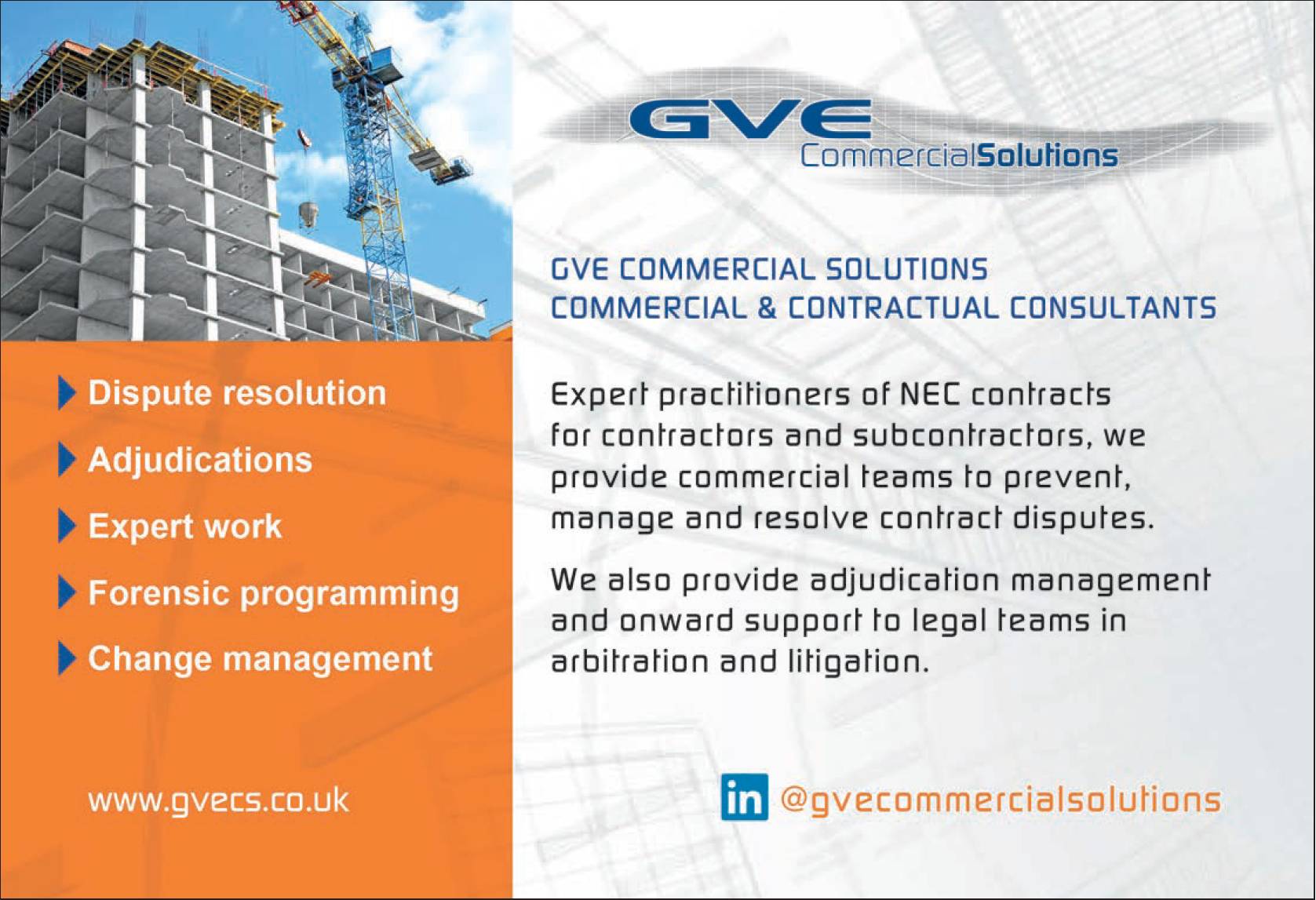NEC3 and NEC4
Andy Inchmore, Managing Surveyor, GVE Commercial Solutions

THE NEC forms of contract are often regarded as a powerful tool in dispute avoidance with their emphasis on regular and detailed communication. These requirements alongside the collaborative ethos, ensure most disputes are resolved before they have a chance to escalate.
What provisions are in place when disputes do occur?
Aside from the more general dispute avoidance measures adopted throughout the NEC contracts, provisions for dispute resolution are found in the main option W clauses. The standard NEC3 and NEC4 contracts provide for the employer to choose which dispute resolution procedure applies to the contract and to fill in the contract data part one accordingly.
NEC3 provides two option clauses, namely W1 and W2, and adopts a two-tier approach to dispute resolution. The first step is adjudication, then if the dispute is still not resolved, it can be referred to the tribunal (usually arbitration or litigation).
NEC3 option W1 Option
W1 should only be used where the Housing Grants, Construction and Regeneration Act 1996 (as amended) (HGCRA) does not apply to the contract i.e. if it is not a construction contract for construction operations within the meaning in the act. As NEC3 is an international contract, this W option can be used outside the UK, so long as it satisfies local rules on adjudication.
Option W1 should only be used where the Housing Grants, Construction and Regeneration Act 1996 (as amended) (HGCRA) does not apply to the contract i.e. if it is not a construction contract for construction operations within the meaning in the act. W1 identifies a series of potential areas of dispute and sets out which party may refer a dispute and when it may be referred to an adjudicator. These details are set out in the adjudication table in Figure 1. The party referring the dispute to the adjudicator includes within their referral information to be considered by the adjudicator. Any further information is to be provided within four weeks of the referral.
The adjudicator is to decide the dispute, with reasons, within four weeks of the end of the period from receipt of the information. The period may be extended by agreement between the parties. The minimum period, therefore, for an adjudication under option W1 is eight weeks.
NEC3 option W2 Option
W2 should be chosen when the HGCRA does apply. The clauses provide a process and timeline for referring a dispute to adjudication. The first step for referring an adjudication is to provide a notice to the other party. If there is named adjudicator in the contract data, they should also receive a copy of the notice. The referring party then has seven days from notice of adjudication to refer the dispute to the adjudicator. Both parties then have 14 days to provide the adjudicator with more information regarding the dispute, unless agreed otherwise by the parties and the adjudicator.

The adjudicator has 28 days from the date which the referring party referred the dispute to the adjudicator to provide their decision.
The next generation of the NEC form of contracts (NEC4) was launched in June 2017 and with it came some major changes to the dispute resolution options. This timeline can be extended up to 14 days with agreement of the referring party, or a longer period if the parties argue. Once the decision has been made, a party has four weeks to notify the other if it wishes to refer the dispute to the tribunal, otherwise the intention is that the adjudicator’s decision becomes final.
NEC4
The next generation of the NEC form of contracts (NEC4) was launched in June 2017 and with it came some major changes to the dispute resolution options. Notably, the W clauses in NEC4 are now located under the section titled ‘resolving and avoiding disputes’ rather than ‘dispute resolution'.
This deliberate rebranding reflects the changes introduced which seek to resolve or avoid issues before they become disputes. This is in keeping with the overriding ethos of NEC contracts – to proactively address and deal with matters as they arise as opposed to dealing with a complicated and protracted dispute.
The significant change to dispute options W1 and W2 under NEC4 is the addition of a step prior to adjudication called senior representatives, namely W1.1 (in W1) and W2.1 (in W2). Under this approach each party has a senior representative who will meet in an attempt to resolve a dispute before there is an adjudication.
This is in keeping with the overriding ethos of NEC contracts – to proactively address and deal with matters as they arise as opposed to dealing with a complicated and protracted dispute.
The senior representatives are set out in the contract data. The concept of senior representatives meeting to try and resolve disputes is not a new one, however it is becoming more commonplace as a contractual requirement within construction contracts. It is seen that this process may assist in closing out matters before costs escalate and tensions rise between the parties, often to the detriment of a project.
Similar to NEC3, clause W1 is used when the HGCRA is not applicable, whereas clause W2 should be used when it does apply.
NEC4 option W1
NEC4 option W1 makes it a condition precedent that a dispute is referred to senior representatives before it is referred to adjudication. Only if the dispute has not been resolved after the senior representative process can the dispute be referred to adjudication.
The adjudication table of NEC3 is replaced in NEC4 by the dispute reference table as shown in Figure 2 which similarly sets out which dispute can be referred and by which party. The process requires the referring party to notify the senior representatives, the other party and the project manager, of the nature of the dispute. The parties exchange their statements of case within one week of notification. Unless otherwise agreed, the statements comprise no more than 10 sides of A4 paper together with supporting information. The senior representatives then meet as many times as necessary over a period of no more than three weeks to discuss the issues. A list of agreed and not agreed issues is produced with the agreed issues being put into effect. The not agreed issues must be referred to adjudication within two weeks, otherwise the right to do so will be lost.

NEC4 option W2
Under clause W2, the use of senior representatives is not mandatory otherwise it would conflict with the HGCRA provisions which states that any party may take a dispute to adjudication at any timeSignificantly, under clause W2, the use of senior representatives is not mandatory otherwise it would conflict with the HGCRA provisions which states that any party may take a dispute to adjudication at any time. Its use as a step in the dispute resolution process is, therefore, optional. It is also of note that if the senior representative route is chosen under W2, any list of not agreed items is not subject to the same time bar as seen in W1.
This is, again, due to the parties’ rights under the HGCRA to adjudicate at any time. Should the dispute be referred to adjudication, the process generally follows that as set out in NEC3 (but see the NEC4 amendments below).
NEC4 option W3
NEC4 also goes a step further and includes an option for a dispute avoidance board (DAB), which can be utilised under new clause W3. The DAB is an alternative to adjudication. As with option W1, option W3 is used when the HGCRA is not applicable to the contract.
The DAB is made up of either one or three members who are identified within the contract data. The purpose of the DAB is to act impartially in an attempt to resolve potential disputes before they crystallise into disputes. The DAB is required to visit site regularly to inspect the progress of the works and become aware of any potential disputes. If a potential dispute is identified, the DAB should provide a recommendation to resolve the matter. If the recommendation is disputed by the parties, they must issue a notice of dissatisfaction within four weeks before referring the dispute to tribunal.
The DAB is made up of either one or three members who are identified within the contract data. The purpose of the DAB is to act impartially in an attempt to resolve potential disputes before they crystallise into disputesIt might be considered that the introduction of the DAB within NEC4 is to compete with FIDIC as the ‘go to’ contract on large international projects.
W options
It should be noted that W options are not available on all NEC forms.
The table in Figure 3 identifies which forms of the NEC suite incorporate the W options and where the dispute resolution provisions can be found in the other forms.
Jan 2019 amendments
In January 2019, in order to build on the constructive feedback and further improve the contracts the NEC published a set of amendments. An addition was made to clauses W1.1(1) and W2.1(1) to allow either party to replace its senior representative after notifying the other party of the name of the replacement. This provides a formal process to change the senior representatives, which otherwise would require the mutual agreement of the parties.

Jan 2023 amendments
In summary, NEC4 has introduced some useful tools within the dispute resolution clauses to encourage the early resolution of disputes.Further amendments were introduced in January 2023. The dispute resolution clause has been amended to ensure compliance with the act. Section 108 (2) (f) of the HGCRA provides that construction contracts shall include written provision to enable an appointed adjudicator to ‘take the initiative’, with further detail on the adjudicator’s powers provided within part 1 of The Scheme for Construction Contracts (as amended) that includes:
- Deciding on the procedures to be followed (paragraph 13).
- Giving directions as to the timetable to be followed (paragraph 13 (g)).
W2.3 now provides that the adjudicator decides the procedure and timetable for the adjudication.
Summary
In summary, NEC4 has introduced some useful tools within the dispute resolution clauses to encourage the early resolution of disputes. Under NEC3, adjudication was the first and only step to resolve disputes. However, whilst in principle the use of senior representatives may be seen as a useful method to resolve issues and minimise costs, in practical terms, unless the parties are fully committed to resolving disputes in this way it may simply add another layer of complexity to the dispute resolution process, increase costs and perhaps even prolong the process.
Andy Inchmore, Managing Surveyor, GVE Commercial Solutions
